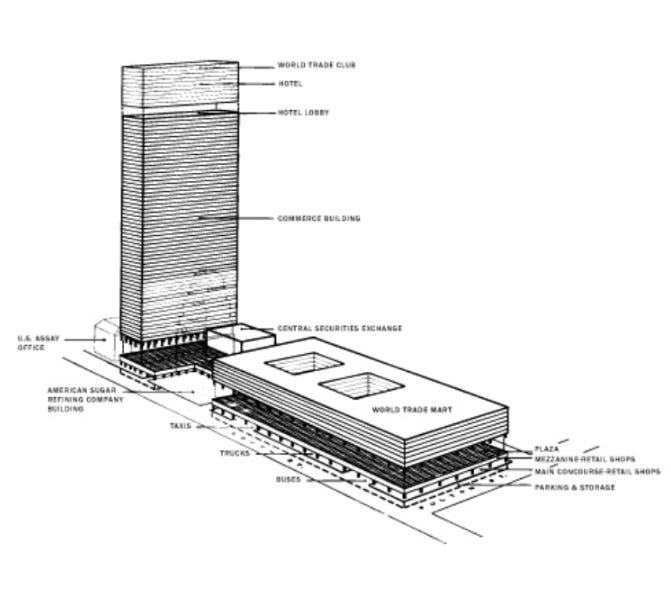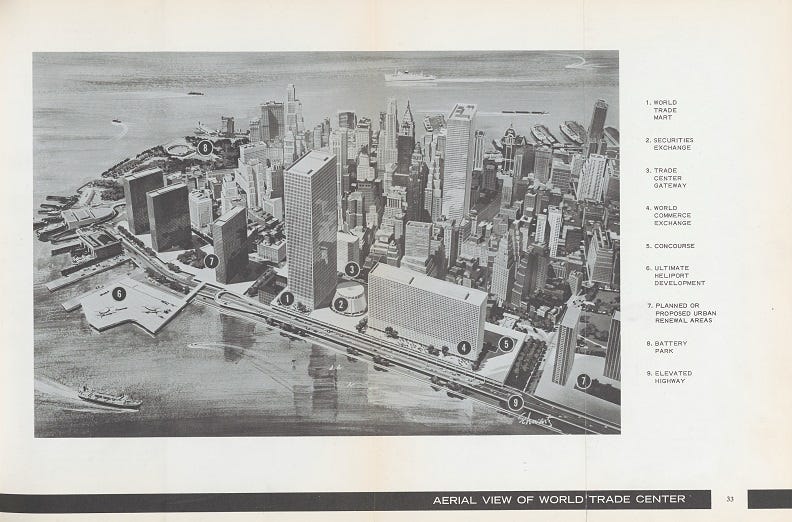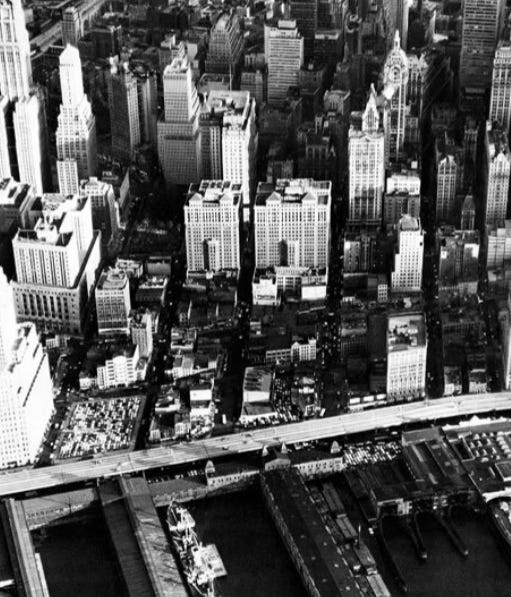The Empire State Building was first conceived sometime after June 1st, 1929, when the previous developer of the Waldorf Astoria lot missed his financing payment. By early August, Raskob and the other developers had acquired the property. By late August, the project was announced, and by the end of September the contractor had begun clearing the site. Altogether, less than 4 months passed between the idea for the project and moving dirt for it.
The World Trade Center, on the other hand, had a less straightforward development path.
The origins of the project can be traced back to a World Trade Center pavilion built at the 1939 New York World’s Fair. The pavilion, which was sponsored by a group of trade associations and businesses, hosted trade groups that were visiting the fair, and was dedicated to the idea of “world peace through world trade.”

The pavilion was temporary, but it inspired the idea of a permanent location where “the fruits of manufacturing skill from every country in the world can be brought together in one place for display and exchange.” The state of New York began considering the project sometime in 1943, and in 1946 passed a bill authorizing the creation of a World Trade Corporation to develop the center, with a budget of $100 million ($1.5 billion in 2022 dollars). Chairman of the corporation was Winthrop Aldrich, president and chairman of Chase National bank, brother-in-law of John Rockefeller Jr. (the son of Standard Oil co-founder John Rockefeller), and one of the organizers of the 1939 World Trade Center pavilion.
The proposed trade center concept was roughly based on Germany’s Leipzig Trade Fair, and called for 21 buildings spread over 10 city blocks. It would include display areas for “agriculture products, forestry, electronics, aviation, textiles…home appliances, industrial arts, transportation, machinery and tools, medicine and chemistry, metallurgy, manufacturing, motion pictures, plastics, electrical goods, and automobiles.” It would also include areas for Europe and South America, a symphony hall, and a World Trade Shrine, along with plenty of underground parking. The hope was that, coupled with the enormous output of America’s production machine that had been untouched by the war, such a trade center would aid the adoption of “Made in USA” products around the world.
But the proposed trade center was put on hold in November of 1946, just 4 months after the creation of the World Trade Corporation. This was due partly to the projected cost, which had risen to $150 million, and partly to analysis suggesting that the project would only be viable if 80% of the 6000 largest companies in the US became tenants of it. Subsequent proposals by the World Trade Corporation (such as rehabilitation of the city’s piers) were similarly ignored, and the corporation dissolved itself in 1949 without anything having been built.
The world trade center concept lay dormant for the next several years, until it was revived by David Rockefeller, son of John Rockefeller Jr., nephew to Winthrop Aldrich, and executive at what was now Chase Manhattan Bank. Following a merger with the Manhattan Company in 1955, Chase needed a new headquarters, and Rockefeller hoped to consolidate its employees (who were spread across nine different locations in New York’s financial district) under one roof. Rockefeller favored keeping the headquarters in the financial district in lower Manhattan, but the future of the area was in doubt. The past several decades had seen development in Manhattan shift north to Midtown, and little new construction had taken place in the area around Wall Street since the 1920s. The financial district, according to Rockefeller, was “cramped, dirty, congested, and a ghost town after 5 pm.” Rockefeller proceeded with the plans for a new headquarters there, but was advised by his friend Robert Moses that such a plan was likely to be a mistake without some way to encourage further development in the Lower Manhattan area.
To help maintain New York’s financial district (and speculatively, to protect the value of the property he owned there), Rockefeller organized the Downtown-Lower Manhattan Association (DLMA), an advocacy group consisting of executives and business owners with an interest in encouraging development in lower Manhattan. In 1959, the DLMA revived the concept of a world trade center, now calling it a “World Trade and Finance Center,” as a place where
the United States and foreign business and financial interests can meet to do business; where representatives of the United States and foreign governments are available for consultation and aid; and where facilities are available to expedite business transactions. Such a center might accelerate the development of international business and act as a symbol of this country’s growing world leadership in the international business community.
The DLMA hired McKinsey to study the concept. Unfortunately for Rockefeller and the DLMA, Mckinsey’s preliminary findings weren’t what they wanted to hear:
The World Trade Center, McKinsey & Co. had determined, could be a serious financial bust. Almost nothing about the concept—its mission or its target client base—was assured. Major corporations had already started exploiting international trade and would gain little real advantage from a World Trade Center, the firm’s report said. All the necessary services were available already. There was no need to put them in one place. Perhaps most embarrassing of all to Rockefeller, the consultants reported that what made the plan an even more likely failure was the decision to build the trade center downtown. Everyone knew that the important business had relocated to Midtown. Why would anyone suffer the “personal inconvenience” of moving downtown, the report asked?
Undeterred by these results, the DLMA fired McKinsey, and hired Skidmore Owings and Merrill (SOM), the firm that had designed Chase’s new headquarters, to come up with a plan for a world trade center in lower Manhattan. SOM’s plan, revealed in 1960, was reminiscent of the concept put forth by the World Trade Corporation in 1946. It consisted of a 13.5 acre site which would contain a 70 story office tower, a hotel, a trade mart, an exhibition hall, a securities exchange, and a theater, along with restaurants and shops. Together, the trade center would consist of 5 or 6 million square feet of space (by comparison, the Empire State Building is 2.7 million square feet, and 2.2 million rentable square feet).

Because of the size of the project, Rockefeller felt that the only organization capable of financing it was the Port Authority, a bi-state public benefit corporation chartered by New York and New Jersey to manage the region’s airports, shipping, and transportation. The Port Authority, first formed in 1921, had grown into an organization of 5000 employees that managed more than $1 billion worth of infrastructure. Its head, Austin Tobin, was the second highest paid public official in the US, after the president.
Though it had originally been a recipient of state funds, by the 1960s the Port Authority was generating significant revenues from tolls on the region's bridges and tunnels - in 1960 it brought in $79 million (just under $800 million in 2022 dollars). These revenues, coupled with the Port Authority’s ability to issue bonds (bypassing the state’s constitutional debt limit) and condemn property, gave it the ability to finance and construct truly enormous projects.
Rockefeller discussed the project with Tobin, who was strongly in favor of it. Tobin felt that in the absence of other forces, the Port Authority was likely to be pressured into developing mass transit projects such as commuter rail, which he viewed as a “fiscal sinkhole” that would imperil the Port Authority’s financing machine. The Port Authority issued bonds to fund the construction of new projects, and the revenue generated from those projects allowed the issuing of more bonds. Being forced to build money-losing mass transit projects threatened the whole system, and a large, revenue generating, non-transit project that the Port Authority could fund instead compelled Tobin.
Following discussions with Rockefeller, the Port Authority commissioned its own study for the project, “A World Trade Center in the Port of New York”, which was completed in 1961. The Port Authority’s proposed trade center largely mimicked the SOM design, as well as its location on the east side of lower Manhattan. The cost of the project was estimated to be $355 million.
Unlike McKinsey’s preliminary report, the Port Authority study was strongly in favor of the project. It noted that New York’s share of cargo entering the US had reached a record low, and that “It is thus of overwhelming importance to the metropolitan area of northern New Jersey and New York…to do everything possible to maintain the preeminence of the Port of New York, to insure that increasing amounts of cargo in foreign trade continue to move through the Port.” The trade center, which would provide facilities to centralize the various trading activities, would accomplish this, but because of the size and scope of the project, only a public agency (like the Port Authority) could successfully construct it.


The bi-state nature of the Port Authority required agreement from both the New York and New Jersey state governments to develop the project. Thanks to the support of governor Nelson Rockefeller (David Rockefeller’s brother), New York was in favor, but New Jersey balked at the project; governor Robert Mayner saw little benefit for New Jersey in it. The project thus once again sat dormant until the end of 1961, when a deal was reached with the newly elected governor of New Jersey, Richard Hughes. In exchange for New Jersey’s approval, the Port Authority would take over the bankrupt Hudson and Manhattan rail service, which ran between New York and New Jersey - it would be renamed Port Authority Trans Hudson, or PATH.[1] Instead of east Manhattan, the trade center would be built on a 16 acre site surrounding the Hudson and Manhattan’s Manhattan terminal, two twenty-two story buildings that had been the US’s largest office buildings when they were built in 1908, but were now outdated. They, along with the rest of the site, would be razed, and a new rail terminal would be included in the project, bringing the estimated cost of the project to $450 million.

In an attempt to ensure this would be the first and last time the Port Authority would take on a money-losing transit project, Tobin included in the agreement a provision that the Port Authority couldn’t subsidize any future mass transit rail projects unless all its existing bonds had been repaid. (In 1973, when the governors of New York and New Jersey jointly tried to rescind this agreement, the Port Authority bondholders filed suit, and the case eventually reached the Supreme Court. When the court found for the bondholders, it resulted in the cancellation of a proposed PATH extension).
Sometime during these negotiations, possibly to offset the costs that would be incurred from operating PATH with additional revenues, Tobin increased the size of the project - from 5 or 6 million square feet to 10 million rentable square feet, nearly 5 times the size of the Empire State Building.
With an agreement reached, the bill funding the project was signed by the governors of New York and New Jersey in March 1962, and the search for a project architect began.
- ^
Other potential new names for the service included Manhattan Operating Trans-Hudson Electric Railway, or MOTHER.
